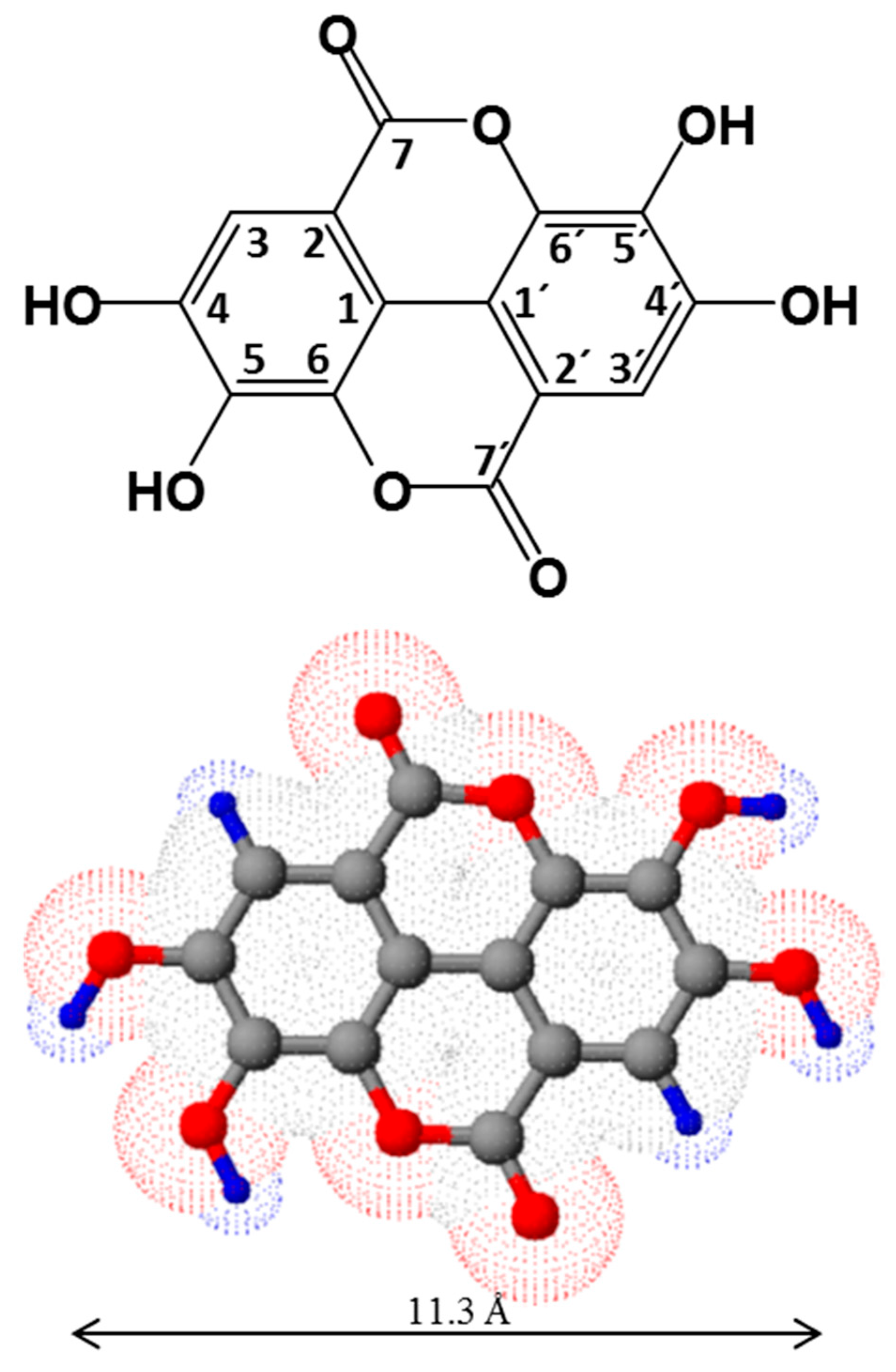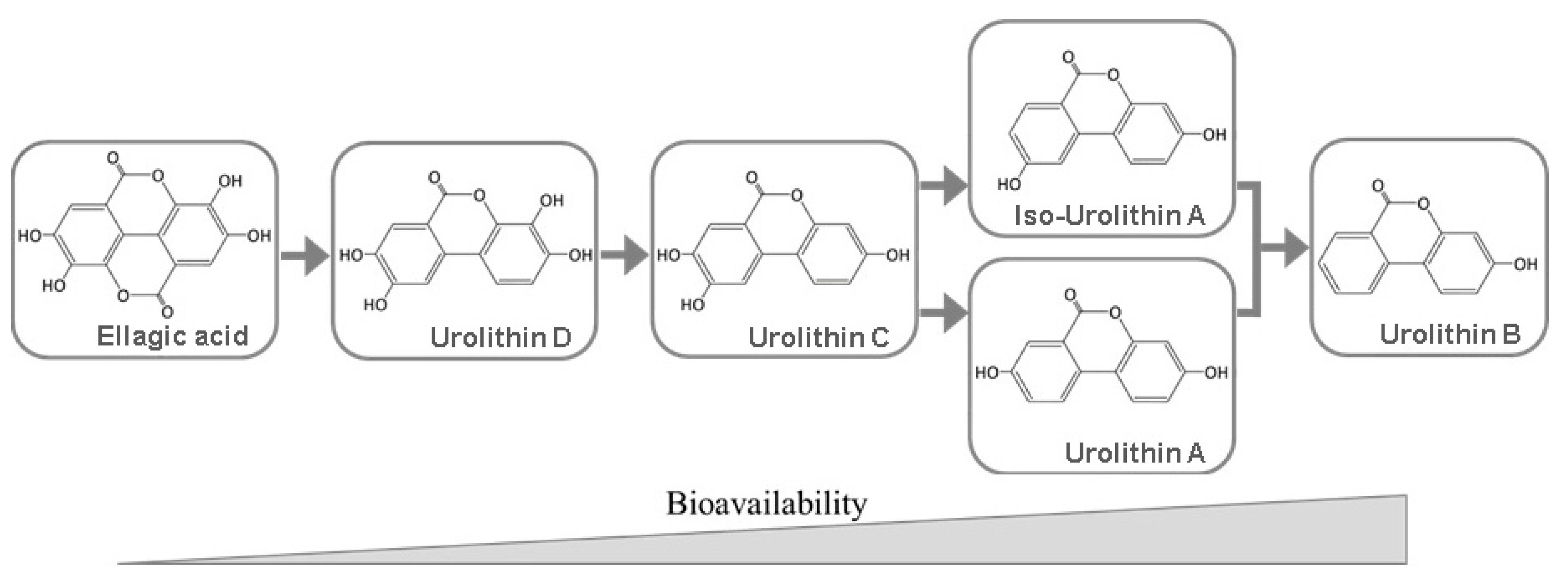1000/1000
Hot
Most Recent

Ellagitannins (ETs), characterized by their diversity and chemical complexity, belong to the class of hydrolysable tannins that, via hydrolysis under acidic or alkaline conditions, can yield ellagic acid (EA). They are mostly found as a part of extractives in angiosperms. As known antioxidants and chelators, EA and EA derivatives are drawing an increasing interest towards extensive technical and biomedical applications.


|
Source |
Latin Name |
Total ET/EA # |
Free EA |
Ref. |
|---|---|---|---|---|
|
Fruits |
||||
|
Arctic bramble |
Rubus arcticus |
3900 (fw) |
- |
[29] |
|
Blackberry |
Rubus ursinus |
1500 ± 140 (dw) |
- |
[47] |
|
Camu-camu fruit: |
Myrciaria dubia |
[34] |
||
|
Pulp powder |
258.5 ± 4.3 (dw) * |
56.0 ± 1.1 (dw) |
||
|
Flour |
5656.6 ± 11.3 (dw) * |
764.9 ± 4.9 (dw) |
||
|
Peel |
71.4 (fw) * |
Nd |
||
|
Pulp |
67.3 (fw) * |
Nd |
||
|
Seeds |
2819.8 (fw) * |
50.4 (fw) |
||
|
Cloudberry |
Rubus chamaemorus |
3600 (fw) |
- |
[29] |
|
3151 (fw) |
- |
[28] |
||
|
Cranberries |
Vaccinium |
120 ± 4 (dw) |
- |
[47] |
|
Guava |
Psidium guajava L. |
57.2–306 (dw) |
- |
[48] |
|
Kakadu plum |
Terminalia ferdinandiana |
30,510–140,250 (dw) |
- |
[30] |
|
8796.0 ± 156.0 (dw) |
6206.0 ± 22.0 (dw) |
[31] |
||
|
Muscadine grapes |
Vitis rotundifolia |
360–912 (fw) |
- |
[36] |
|
Pomegranate: |
Punica granatum |
[35] |
||
|
Mesocarp |
40,595.4 ± 4434.2 (dw) |
234.2 ± 13.0 (dw) |
||
|
Peel |
43,979.0 ± 394.8 (dw) |
637.7 ± 32.8 (dw) |
||
|
Red raspberry |
Rubus idaeus |
1500 ± 100 (dw) |
- |
[47] |
|
1900–2700 (fw) |
- |
[29] |
||
|
2637–3309 (fw) |
- |
[28] |
||
|
Rose hip |
Rosa rugosa |
1096 (fw) |
- |
[28] |
|
Strawberry |
Fragaria ananassa |
630 ± 90 (dw) |
- |
[47] |
|
650–850 (fw) |
- |
[29] |
||
|
683–853 (fw) |
- |
[28] |
||
|
Processed Fruits |
||||
|
Pomegranate juice |
- |
87–2118.3 (mg·L−1) |
2.1–7.7 (mg·L−1) |
[35] |
|
Raspberry jam |
- |
764 (fw) |
- |
[28] |
|
Strawberry jam |
- |
245 (fw) |
- |
[28] |
|
Seeds and Nuts |
||||
|
Pecans |
Carya illinoensis |
330 ± 0.3 (dw) |
- |
[47] |
|
Walnuts |
Juglans nigra |
590 ± 0.3 (dw) |
- |
[47] |
|
Wood |
||||
|
Blue gum |
Eucalyptus globulus |
- |
500–1700 (dw) |
[41] |
|
Common Oak |
Quercus robur |
- |
81–228 (dw) |
[49] |
|
Pyrenean oak |
Quercus pyrenaica |
- |
66–219 (dw) |
[49] |
|
Rose gum |
Eucalyptus grandis |
- |
280–512 (dw) |
[40] |
|
Sessile oak |
Quercus petraea |
- |
109–198 (dw) |
[49] |
|
Sweet chestnut |
Castanea sativa |
- |
74–140 (dw) |
[49] |
|
White oak |
Quercus alba |
- |
132–277 (dw) |
[49] |
|
Wood bark |
||||
|
Blue gum |
Eucalyptus globulus |
- |
471 (dw) |
[50] |
|
(Hybrid) eucalypt |
Eucalyptus urograndis |
- |
2243–2307 (dw) |
[51] |
|
Maidens Gum |
Eucalyptus maidenii |
- |
1130–1178 (dw) |
[51] |
|
Oak |
Quercus robur + Quercus petraea |
- |
2200–3700 (dw) |
[52] |
|
Sweet chestnut |
Castanea sativa |
- |
4300–9300 (dw) |
[53] |
|
Rose Gum |
Eucalyptus grandis |
- |
2639–2721 (dw) |
[51] |
|
Other sources |
||||
|
Eucalypt leaves |
Eucalyptus globulus |
3320.0 ± 80.0 (dw) |
- |
[54] |
|
Filtrates from unbleached kraft wood |
Eucalyptus globulus |
- |
98 ± 0.7 (mg/L) |
[41] |
|
Sulphite spent liquor |
Eucalyptus globulus |
- |
1165.5 (mg/L) |
[55] |

The above-mentioned structural features of EA, ETs and derivatives have a vital role in maintaining cellular homeostasis and bestowing these compounds with preventive and protective properties in many biological systems and cell types. It has been reported a wide range of possible biomedical/pharmaceutical applications, which are briefly summarized in Table 2.
Table 2. Possible biological effects of EA and its derivatives.
|
Activity |
Active Compound |
Main Features |
Ref. |
|---|---|---|---|
|
Antibacterial (Gram-Positive) |
Commercial extract of pomegranate byproduct (POMx) and punicalagin |
Inhibited the growth of pathogenic Clostridium and Staphyloccocus aureus |
[78] |
|
Antibacterial (Gram-Positive) |
Ellagic acid |
Action against Bacillus luteus and Listeria monocytogenes |
[79] |
|
Antibacterial (Gram-Negative) |
Tellimagrandin I |
Time- and dose-dependent bactericidal activity against Helicobacter pylori |
[80] |
|
Antibacterial (Gram-Negative) |
Ellagic acid |
EA—cyclodextrin complex expressed activity against Escherichia coli and Pseudomonas aeruginosa |
[79] |
|
Antimycobacterial |
Punicalagin |
Inhibited the growth of Mycobacterium tuberculosis typus humanus ATCC 27294 and patient strain of Mycobacterium tuberculosis sensitive to the standard antituberculosis drugs |
[81] |
|
Antileishmanial |
Geraniin, phyllanthusiin B and elaeocarpusin |
Exhibited effect against protozoa Leishmania donovani, comparable to that of the amphotericin B |
[82] |
|
Antimalarial |
Ellagic acid |
In vitro against all Plasmodium falciparum strains. In vivo against Plasmodium vinckei petteri; potentiates the activity of chloroquine, mefloquine, artesunate and atovaquone |
[83] |
|
Antibabesial |
Ellagic acid |
In vivo against Babesia microti; EA nanoparticles as an alternative antiparasitic agent |
[84] |
|
Antifungal |
Candelitannin (ellagitannin) isolated from E. antisyphilitica Zucc. |
Effective against Alternaria alternata, Fusarium oxyzporum, Colletotrichum gloeosporoides and Rhizoctnia solani |
[85] |
|
Antifungal |
Ellagic acid |
Action against Candida albicans |
[79] |
|
Antiviral |
Castalagin, vescalagin and grandinin. |
Action against acyclovir (ACV)—resistant strains of Herpes simplex virus HSV−1 and HSV-2; synergistic effects when used in combination with ACV |
[86] |
|
Prebiotic effect |
Commercial extract of pomegranate byproduct (POMx) and punicalagin |
Enhanced growth of Bifidobacterium breve and Bifidobacterium infantis |
[78] |
|
Anti-inflammatory |
Ellagic acid, gallic acid and punicalagin A&B |
Potential inhibition of LPS-induced NO, PGE-2 and IL-6 production |
[87] |
|
Anti-inflammatory |
Ellagic acid |
Enhancement of EA’s anti-inflammatory properties in vivo by inclusion complex of EA with hydroxypropyl-β-cyclodextrin |
[88] |
|
Treatment of Type 2 diabetes mellitus |
Ellagic acid and ETs from Agrimonia pilosa Ledeb. |
Inhibition of protein tyrosine phosphatases (PTP1B) |
[13] |
|
Prevention of diabetic complications |
Ellagic acid |
ALR2 (aldose reductase) inhibition and antiglycating effect of EA could possibly delay progression of cataract |
[89] |
|
Anticancerous agent |
Ellagic acid |
Inhibition of SphK1 (sphingosine kinase 1) |
[11] |
|
Antiangiogenic and antiproliferative effect |
Ellagic acid |
Reduction in metastatic potential of bladder cancer and enhancement of the efficacy of anti-VEGF-A therapies |
[7] |
|
Gastroprotective |
Ellagitannin-rich fraction obtained from E. citriodora |
Possibly due to their antioxidant, anti-inflammatory and anti-apoptotic properties. Partially mediated by attenuating induced oxidative stress and by the reduction of pro-inflammatory markers. |
[90] |
|
Hepatoprotective |
Ellagic acid |
Suppression of caspase-3, bcl-2, NF-kB and Nrf-2 |
[6] |
|
Antiarrhythmic |
Ellagic acid |
Antilipid peroxidation property and antihyperlipidemic activity through 3-hydroxy-3 methyl glutaryl CoA reductase inhibition; cardioprotective effect |
[91] |
|
Antiasthmatic |
L. pacari extract and ellagic acid |
Effective eosinophilic inflammation suppressors |
[92] |
|
Antihyperlipidemic |
Ellagic acid |
EA-CoQ10 nanoparticles effectively attenuated induced hyperlipidemia in rats |
[93] |
|
Antiepileptic |
Ellagic acid |
Possibly achieved through increase of brain GABA levels |
[9] |
|
Antianxiety |
Ellagic acid |
Possible involvement of GABAergic system in the anxiolytic action |
[10] |
|
Antidepressant |
Ellagic acid |
Possible interaction through adrenergic and serotonergic systems or through inhibition of inducible NOS |
[8] |
|
Neuroprotective in SAD |
Ellagic acid |
Diminished oxidative stress profile, pro-inflammatory markers, acetylcholinesterase activity, and amyloid-β plaque level in induced SAD (Sporadic Alzheimer’s Disease) rats |
[12] |
|
Skin-whitening agent |
Ellagic acid |
EA acts as an alternative substrate of tyrosinase, inhibiting the melanogenesis process |
[94] |